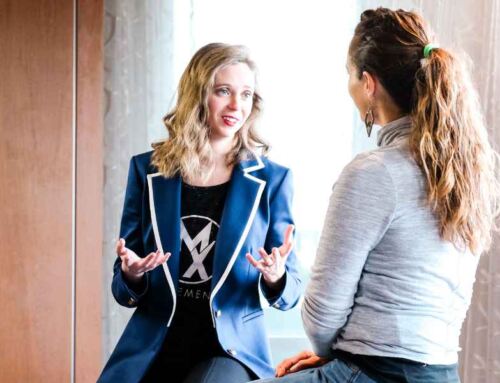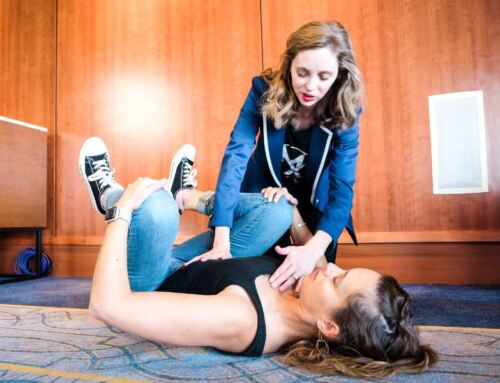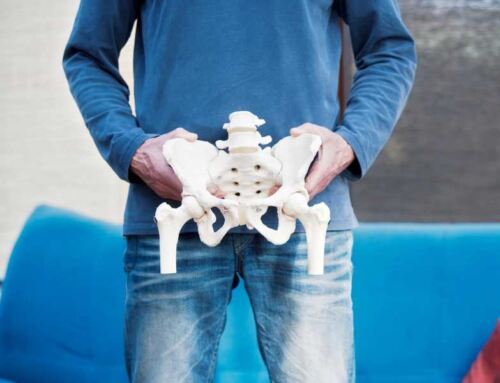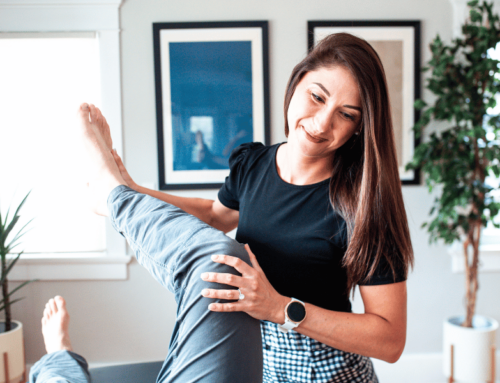As a veteran Mom, Vestibular Physical Therapist, and a person with a vestibular disorder, I can tell you from first hand experience how strong the connection is between hormonal changes during pregnancy and postpartum, lack of sleep, and increased stress on vestibular symptoms.
Experiencing pregnancy and childbirth for a second time recently, I thought I knew what to expect during my pregnancy, the birthing process, and in the recovery afterwards. So, when my son Damian was born in January 2022, I felt that I was in a much better place mentally and physically in my preparation for the experience of childbirth, for navigating the “4th trimester”, and to take care of a newborn, than I was with my first son, Lucas.
What I didn’t realize at the time was that I would have some additional challenges in my postpartum recovery that I didn’t quite plan for.
My Own Experience with Vestibular Migraines
Pregnancy and childbirth themselves are huge, life-changing experiences for most women, so I knew my life would never be the same after having my children. However, I never thought that during this magical time of pregnancy, I would experience a very different type of life-changing event called vertigo ( a spinning type of dizziness) which would really change my life indefinitely.
I had been only 10 weeks into my first pregnancy when my first episode of this extremely common vestibular disorder took me by surprise. I was working at an outpatient physical therapy clinic in New Jersey at the time, and in the middle of my work day. I turned around quickly to talk to my patient, just as I had done millions of times before, but this time, the entire world suddenly began to spin violently. This was followed immediately by nausea, blurred vision, sensitivity to light and sound, unsteadiness, and later, by a mild headache. The entire episode lasted only 2 hours total, but while I was suffering from these debilitating symptoms, it felt like an eternity before they subsided.
In those first scary moments when the spinning, nausea, and panic set in, like most pregnant women, I immediately thought, “Is the baby ok?!” Yes, the baby was totally fine, but he was the trigger for the onset of my symptoms. The changes my body was experiencing hormonally at the time was the catalyst for my first episode of many episodes to follow of Vestibular Migraine (AKA “Dizzy Migraine”) which I was officially diagnosed with weeks later.
What are Vestibular Migraines?
Migraine is one of the most debilitating chronic disorders in the United States. About 40% of migraine sufferers also have a vestibular syndrome involving disruption in their balance and/or dizziness at one time or another (see references 1 & 2 below).
Vestibular Migraine (VM), also known as, “Migraine-Associated Vertigo” (MAV), is often difficult to recognize and diagnose. When most people think about having a migraine, they think of severe head pain that has the power to incapacitate someone for hours, along with nausea and vomiting. However, many people with migraine will often experience no head pain at all.
Instead, the primary symptoms that can occur with their migraines are vertigo (a spinning sensation) dizziness/ disequilibrium (balance loss), nausea, with or without vomiting, sensitivity to light, sound, or smells, mental confusion, disorientation, detachment from reality (depersonalization), difficulty speaking, ringing in the ears (tinnitus), visual distortion or blurred vision, or weakened/impaired muscle movements.
Who experiences Vestibular Migraines?
Vestibular migraine is one of the most common causes of spontaneous, recurrent episodes of vertigo (spinning dizziness) and accounts for about 10% of patients with vertigo and dizziness in the general population. It is almost as prevalent as high blood pressure (hypertension) and is more common than asthma and diabetes. More importantly, migraine strikes people during what are expected to be their most productive years: between ages 20 and 40 for most women, with a slightly higher age range for men. Similar to other subtypes of migraine, Vestibular Migraine is 1.5–5 times more common in women than in men (2,3).
Recently, throughout my second pregnancy, I was blessed to not have any episodes of vestibular migraine. Between 50 and 80% of pregnant migraine patients actually experience a reduction in migraine attacks during their pregnancy.4 However, the hormone changes postpartum, plus the increased stress of transitioning into being a mom of 2 with a now 7 year-old and a newborn, combined with significant lack of sleep, have triggered several episodes for me over the last few months. Fortunately, I have been adhering to the behavioral changes that help me manage my own personal migraine triggers, take care of my body, and my vestibular system.
So how can I manage my Vestibular Migraines?
Although vestibular migraines present differently than your typical migraine that can cause significant head pain, the same behavioral and lifestyle changes can be used to help manage the symptoms and the episodes. So if you have the typical type of migraine (with or without aura), these tips can also benefit you.
Here are some of my top tips that I share with all my patients (and use myself) who are either coming to me for treatment for their vestibular migraine symptoms, or have migraines in addition to another vestibular diagnosis.
These life-style changes have also helped me to manage life as a wife, a mom with a newborn and a 7 year old, a career as a mobile physical therapist and a superhero in my spare time (just kidding).
1.) Manage stress with meditation and mindfulness
Migraine is a genetic disorder of dysfunctional sensory processing with headache as a key feature7. But your mood and stress in your life can make it worse. High stress and chronic migraine are associated with lifestyle factors such as medication overuse, smoking, sedentary habits, and obesity (5,6).
Fortunately, many evidence-based techniques used for management of stress and mood disorders can also be used to help manage migraine, including cognitive behavioral therapy, biofeedback, mindfulness, and relaxation techniques (5,6).
Techniques to promote relaxation such as meditation, visualization, progressive muscle relaxation and mindfulness can be very effective. These techniques can be learned from books, apps, or with the help of a psychologist or therapist who specializes in cognitive behavioral therapy.
2.) Improve sleep hygiene and manage fatigue
Poor sleep itself has been described as a migraine trigger (7) and for me, I believe my chronic lack of sleep over the past few months on top of my postpartum hormone imbalances, have been the biggest triggers for my migraine episodes. Make it a habit to sleep when your baby sleeps and try to improve your sleep hygiene with the following tips:
Use your bedroom as a cue for sleep and try to limit your activities other than sleep when in this space. Create a dark and cool room, that is quiet, or if you like, you can use a white noise machine. There should be no screen time while you are preparing for sleep which includes television, iPhones and computers/laptops and tablets. Have a planned bedtime and wake-up, trying not to take naps during the day and get out of bed if you are not sleeping.
You can also try using bedtime relaxation techniques like deep breathing, the techniques mentioned above including meditation, visualization, progressive muscle relaxation. My favorite type of relaxation activity before bed is taking a hot shower where I start to perform some deep breathing exercises. I then follow this up with some meditation or prayer with visualization while laying in bed to fall asleep more quickly.
3.) Understand your migraine triggers
There is no single “migraine diet” that can be generalized to all people who suffer from migraines. However, many people identify and believe that certain foods, beverages, and other environmental factors can trigger migraine episodes and/or increase the intensity of their symptoms. Alcohol and caffeine are the most common diet patterns and diet-related triggers associated with increased frequency of migraine attacks in the literature thus far (7,8).
Most of the diet interventions, such as low-fat and elimination diets, are shown to be related to a decrease in the frequency of migraine attacks. By avoiding your own personal diet-related triggers in your migraine management, you may be able to prevent some of the episodes and possibly minimize the intensity of those symptoms when an episode is present.
Some of the Most Common Triggers for Migraine are:
Note: Some of these triggers may also apply to other types of vestibular dysfunction (see reference 9).
FOOD TRIGGERS
- Aged or ripened cheeses (examples: Cheddar, Brie, Gouda, feta, bleu, Camembert)
- Foods containing large amounts of monosodium glutamate (MSG).
- Smoked, cured, or processed meats such as bacon, sausage, ham, salami, pepperoni, pickled herring, bologna, chicken livers, and hot dogs
- Food prepared with meat tenderizer, soy sauce, vinegar (except white vinegar), or yeast extract; and food that has been fermented, pickled, or marinated
- Pea pods and pods of broad beans such as lima and navy beans
- Onions, olives, pickles
- Alcohol (especially red wine, port, sherry, Scotch, gin, and bourbon)
- Sour cream, yogurt, buttermilk
- Hot fresh bread, raised coffee cake, doughnuts
- Excessive aspartame (artificial sweetener)
- Chocolate, cocoa, carob
- Nuts, peanut butter
- Certain fruits, including figs, avocados, raisins, red plums, passion fruit, papaya, banana, and citrus fruit
- Excessive Caffeine (tea, coffee, cola
OTHER TRIGGERS
- Hormonal fluctuations
- Barometric-pressure variations
- Sleep disturbance
- Stress
- Medications
4.) If you are a pregnant woman, breastfeed if you can
Breastfeeding is not for everyone, but if you suffer from migraine, are pregnant, and considering breastfeeding, I would recommend that you do it—if you are both mentally and physically willing and able to. Not only is breastfeeding super healthy for your baby, but studies have shown that higher estrogen levels during pregnancy and postpartum when breastfeeding can result in reduced migraine symptoms and episodes. Breastfeeding can prevent estrogen levels from dropping after a woman gives birth which can help lower the frequency of migraine attacks in women (4).
It may further help reduce the risk of developing certain medical conditions later in life, including heart disease and diabetes (4,10). Lastly, it can be a way to relieve stress and help you feel more connected to your new baby, in addition to not having the extra stress due to the recent formula shortages across the nation. I believe that my decision to breastfeed my son has helped reduce the number of VM episodes I have experienced thus far postpartum.
5.) Stay hydrated and eat
This is especially important if you are breastfeeding! Women who breastfeed also require approximately 500 additional kcal/day beyond what is recommended for non-pregnant women (10, 11). Thus, eating a healthy, well-balanced and nutrient-dense meal, at least 3 times a day should be your goal as well as avoiding skipping meals. Stay hydrated, aiming for 7–8 glasses (8-oz) of water per day and stop caffeine altogether or consistently use less than 200 mg/day (which is the equivalent of 1-2 cups of brewed coffee).
As mentioned earlier, there is no single “migraine diet”, but many patients believe that some foods trigger their migraine attacks. Further high quality research is still needed to confirm the effect of diet in people with migraine. In the literature we do have, the most consistent food triggers in people with migraine appear to be red wine and caffeine withdrawal (7).
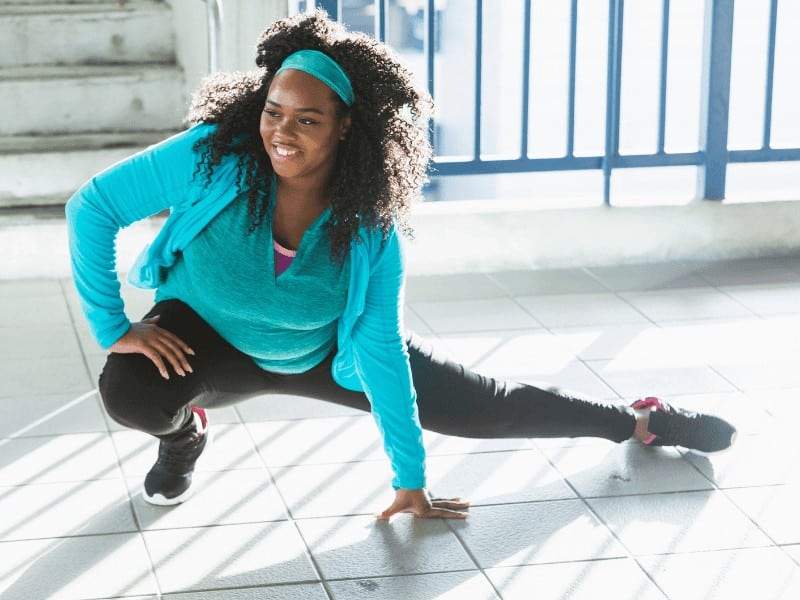
6.) Exercise when you can and as much as you can tolerate
Not only is exercise great for overall health, but some evidence suggests that it can also be useful in the management of migraine (12). Low levels of physical activity and a sedentary lifestyle are associated with migraine. Exercise has also been shown to improve the physical and mental health of postpartum women and enhance their quality of life, decrease postpartum depression, regulate hormones, and improve sleep (13,14,15).
You can start with a goal of 30–60 minutes 3–5 times a week. You can even start smaller, for example, just 5 minutes once a week. Slowly increase exercise duration and frequency to make it a habit. Choose an activity you enjoy since no one type of exercise is best. If headaches are limiting your everyday activities, talk to your doctor about preventive medical treatment and optimizing your rescue medication treatment.
7.) Communicate with your partner, family, friend, or mental health professional
Many vestibular patients struggle with disorientation, confusion and memory loss, as well as anxiety, depression, and social isolation on a daily basis. This can increase your sense of vulnerability, which can negatively affect your self-identity and self-worth. Vestibular disorders are often called “invisible illnesses” because they are invisible to others. Most of the time people with vestibular disorders don’t look sick because the damage/injury to the vestibular system can’t be seen, creating a lack of understanding from other people and a feeling of being misunderstood by those around you.
Expressing your feelings surrounding your own personal experience with vestibular migraine to the people who love and support you, like a partner, a close friend or a family member, can help you feel more understood and less alone. Professional talk therapy is another valuable resource to utilize when you are struggling with the challenges of coping with a vestibular disorder so you can develop self-compassion and acceptance. Counseling or psychotherapy provides support, validation and normalization. Emotions can interfere with and hinder your physical recovery by exacerbating your physical symptoms. Working with a therapist to better manage your emotions will maximize your physical recovery. Participation in a support group can also really help to minimize feeling misunderstood and alone while providing validation (16).
Another great resource that I always offer to all my patients to find support and more information on their vestibular symptoms and diagnoses is the Vestibular Disorders Association (VeDA). VeDA’s website includes a provider directory of vestibular specialists, support group directory, resource library, and other resources for patients, their families and providers: www.vestibular.org.
8.) Keep a diary
Keeping a migraine diary can be a big help not only in expressing your feelings and anxieties surrounding this disorder, but to help you track your episodes, symptoms, and triggers.
Using a calendar, agenda, or app can not only help you track possible patterns in time and frequency of your episodes, but the types of symptoms you are experiencing before, during and after an episode. It can also help by increasing awareness of the triggers in your diet that may potentially be associated with your migraines. Another benefit of a diary is the ability to track how often you are needing to use your rescue medications. You can bring the diary to your follow-up with your doctor to review and he/she can modify medications as needed. Rescue medications should be used fewer than 2 days per week to avoid a rebound headache called a “medication-overuse headache” (7).
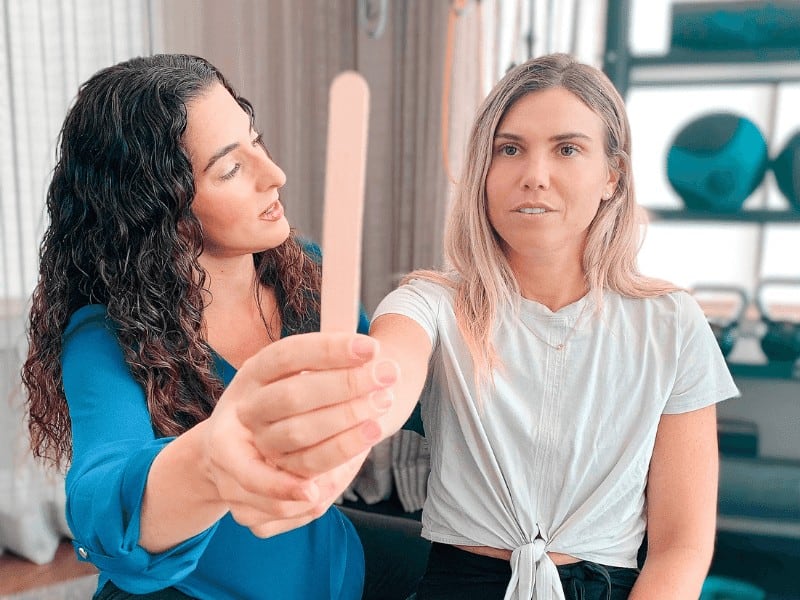
9.) Find a physical therapist who specializes in vestibular rehabilitation
Many patients with Vestibular Migraines benefit from Vestibular Rehabilitation, or VRT, which is a specialized form of exercise-based physical therapy, designed by a specially-trained physical therapist. Vestibular rehabilitation (VR) has been shown to be very effective for many vestibular disorders and current research shows significant improvement in vestibular symptoms and quality of life in Vestibular Migraine patients as well (18). The goal of VRT is to eliminate the symptoms and problems associated with vestibular disorders and uses concepts of neural plasticity (which is the body’s ability to change and adapt itself by re-wiring the circuits in the brain and making new connections).
Each VRT program is developed with customized exercises to address the specific problem(s) of each individual. So, before a VRT exercise program is designed, a comprehensive clinical examination is performed to identify the problems related to vestibular migraine. Specific exercises are then selected to stimulate, adapt, and retrain the vestibular system.
This concentrated rehabilitation program may consist of some of the following examples, but programs are developed specific to the symptoms and needs of each individual:
- Gaze-stability exercises that emphasize improving visual acuity.
- Exercises emphasizing proprioception and visual perception
- Visual tracking exercises to stabilize alterations in a positional sense.
- Vestibulo-visual interaction exercises to improve eye tracking abilities
- Balance retraining and gait-training tasks and exercises to improve postural instability and gait alterations
- Habituation exercises to treat symptoms of dizziness that are produced because of self-motion and/or visual stimuli.
- Strengthening and flexibility exercises
- Education on safety and fall prevention
- Education on lifestyle and behavioral changes to decrease symptoms.
- Instruction in mindfulness-based stress reduction techniques
- Cardiovascular and general conditioning exercises
- Functional training (to improve the activities of daily living)
In cases where positional vertigo, or BPPV, is part of the problem, canalith repositioning maneuvers performed by your physical therapist are very effective in resolving symptoms. Patients with neck pain and muscle spasms may also benefit from treatment to address these problem areas which may include modalities for pain management, manual mobilization, stretching and mobilization of hypertonic muscles in your head and neck to resolve the muscle spasms and guarding and restore normal mobility to the neck, muscle strengthening to improve posture, posture analysis with instruction in correcting faulty posture, and a personalized ergonomic assessment of your desk or workstation.
It is often helpful for the patient to have started the prescribed medications prior to beginning the vestibular rehabilitation course (2). This may allow for better tolerance to the exercise regimen without exacerbating the symptoms. Medications may be prescribed to prevent migraines or to stop a migraine that has already started. The intensity of the rehabilitation course is also gradually increased to the patient’s tolerance and always at a level so as to not provoke another migraine event.
Conclusion
In summary, there are a number of ways to take action and better manage your vestibular migraines. Consistently making changes in your lifestyle, modifying your behaviors, and having awareness of your own risk factors and triggers associated with migraine, like those I mentioned above, can help you have more control over your vestibular diagnosis.. Furthermore, by adhering to the medication usage as prescribed by your doctor, and finding a specialist in vestibular rehabilitation to help you effectively reduce the symptoms and functional limitations caused by vestibular migraine, you can successfully keep it under control through all of your life changes.
If you, or someone you know has been diagnosed with a vestibular disorder, and you are in the Florida or NJ area, feel free to reach out to me for free consultation or with any questions you may have. You can also head over to my Instagram page @Dr.DizzyDeBritoDPT or my Facebook page to find more information on vestibular migraine and other vestibular disorders, and how vestibular rehab can help.
If you are outside the Florida or NJ area, MovementX providers span nationwide and still may be able to help you with a provider in your area. You can also head to VEDA to find valuable resources and doctors in your area.
Disclaimer: The above blog post is not to be taken as medical advice or diagnosis for your own unique case. This blog and its content are suggestions for managing vestibular migraines, migraines in general and hormonal changes postpartum from my own personal and professional experience. It’s what’s worked for me and for my patients, but always consult your own doctor and your own physical therapist prior to making any new changes to your own program or lifestyle. The information on this page is designed for general knowledge and informational purposes only and is in no way intended to generally or specifically treat, diagnose, prevent or cure any condition. The information on this page is not intended to be a substitute for informed medical advice or care. You should not use this information to diagnose or treat any health problems or illnesses without consulting your doctor or primary care provider. Do not rely on this page for assistance in regard to your immediate, urgent medical needs.
References:
- Obermann M, Strupp M. Current treatment options in vestibular migraine. Front Neurol. 2014;5:257. Published 2014 Dec 4. doi:10.3389/fneur.2014.00257
- Kramer, J. “Vestibular Migraine or Migraine Associated Vertigo (MAV).” 2014., Vestibular Disorders Association, Article 75, 1-6. https://vestibular.org/article/diagnosis-treatment/types-of-vestibular-disorders/vestibular-migraine/
- Shen Y, Qi X, Wan T. The Treatment of Vestibular Migraine: A Narrative Review. Ann Indian Acad Neurol. 2020;23(5):602-607. doi:10.4103/aian.AIAN_591_19
- Negro A, Delaruelle Z, Ivanova TA, et al. Headache and pregnancy: a systematic review. J Headache Pain. 2017;18(1):106. doi:10.1186/s10194-017-0816-0
- Smitherman, Todd A., Rebecca E. Wells, and Sutapa G. Ford. “Emerging behavioral treatments for migraine.” Current pain and headache reports 19.4 (2015): 1-6.
- Westergaard ML, Glumer C, Hansen EH, Jensen RH. Medication overuse, healthy lifestyle behaviour and stress in chronic headache: results from a population-based representative survey. Cephalalgia 2016; 36(1):15–28. doi:10.1177/0333102415578430
- Robblee J, Starling AJ. SEEDS for success: Lifestyle management in migraine. Cleveland Clinic Journal of Medicine. 2019 Nov;86(11):741-749. DOI: 10.3949/ccjm.86a.19009. PMID: 31710587.
- Hindiyeh, Nada Ahmad et al. “The Role of Diet and Nutrition in Migraine Triggers and Treatment: A Systematic Literature Review.” Headache vol. 60,7 (2020): 1300-1316. doi:10.1111/head.13836
- Ronald J. Tusa, MD, PhD, “Diagnosis and Management of Neuro-otologic Disorders Due to Migraine,” chap. 12 in Vestibular Rehabilitation, ed. Susan J. Herdman, PhD, PT (Philadelphia: F.A. Davis Co., 1994)
- American Academy of Pediatrics and American College of Obstetricians and Gynecologists Committee on Obstetric Practice. Guidelines for perinatal care. 8th Edition; Washington, DC: 2017.
- Kominiarek MA, Rajan P. Nutrition Recommendations in Pregnancy and Lactation. Med Clin North Am. 2016;100(6):1199-1215. doi:10.1016/j.mcna.Pa2016.06.004
- Amin, F.M., Aristeidou, S., Baraldi, C. et al. The association between migraine and physical exercise. J Headache Pain 19, 83 (2018). https://doi.org/10.1186/s10194-018-0902-y
- Sampselle, Carolyn M., et al. “Physical activity and postpartum well‐being.” Journal of Obstetric, Gynecologic, & Neonatal Nursing 28.1 (1999): 41-49
- Ko, Yi‐Li, et al. “Community‐based postpartum exercise program.” Journal of Clinical Nursing 22.15-16 (2013): 2122-2131.
- Daley, Amanda J., Christine MacArthur, and Heather Winter. “The role of exercise in treating postpartum depression: a review of the literature.” Journal of midwifery & women’s health 52.1 (2007): 56-62.
- Bilgrei, R. “Emotional Impacts of Vestibular Disorders.” 2014.Vestibular Disorders Association, Article 057, 1-3.
- Mallampalli MP et al. Care Gaps and Recommendations in Vestibular Migraine: An Expert Panel Summit. Front Neurol. 2022 Jan 3;12:81267
- Ahmet Koc, Elvan Cevizci Akkılıc. Effects of vestibular rehabilitation in the management of patients with and without vestibular migraine, Brazilian Journal of Otorhinolaryngology, 2021, ISSN 1808-8694, https://doi.org/10.1016/j.bjorl.2021.07.011.
About the Author
Dr. Janine DeBrito is a physical therapist and vestibular specialist with MovementX in the Boca Raton area of South Florida. With over 17 years of clinical experience, Janine DeBrito helps patients with a variety of neurological and vestibular diagnoses, such as migraines, BPPV, dizziness, vertigo, imbalance, and other disorders. She enjoys horseback riding, soccer, hiking, running, biking, music, and the beach.




